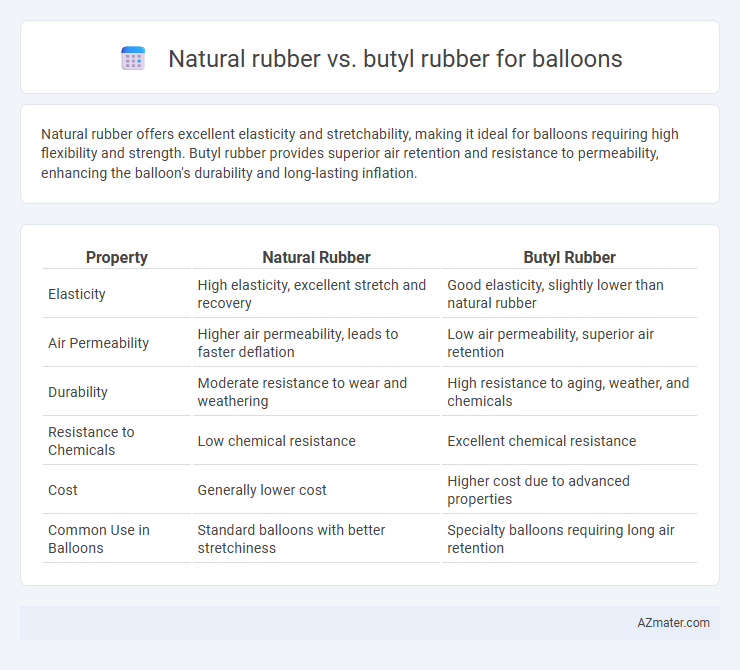Natural rubber offers excellent elasticity and stretchability, making it ideal for balloons requiring high flexibility and strength. Butyl rubber provides superior air retention and resistance to permeability, enhancing the balloon's durability and long-lasting inflation.
Table of Comparison
| Property | Natural Rubber | Butyl Rubber |
|---|---|---|
| Elasticity | High elasticity, excellent stretch and recovery | Good elasticity, slightly lower than natural rubber |
| Air Permeability | Higher air permeability, leads to faster deflation | Low air permeability, superior air retention |
| Durability | Moderate resistance to wear and weathering | High resistance to aging, weather, and chemicals |
| Resistance to Chemicals | Low chemical resistance | Excellent chemical resistance |
| Cost | Generally lower cost | Higher cost due to advanced properties |
| Common Use in Balloons | Standard balloons with better stretchiness | Specialty balloons requiring long air retention |
Introduction to Balloon Materials
Natural rubber offers high elasticity and excellent stretchability, making it a preferred choice for balloons that require significant expansion and vibrant color retention. Butyl rubber provides superior air impermeability and resistance to gas diffusion, enhancing balloon longevity and reducing deflation rates over time. Selecting between natural rubber and butyl rubber involves balancing elasticity needs with durability and air retention for specific balloon applications.
What is Natural Rubber?
Natural rubber, derived from the latex sap of the Hevea brasiliensis tree, offers excellent elasticity and tensile strength, making it ideal for balloon manufacturing. Its biodegradable properties and superior air retention improve balloon durability and flexibility compared to synthetic alternatives. Natural rubber's high resilience and natural protein content contribute to its popularity in producing high-quality, stretchable balloons.
What is Butyl Rubber?
Butyl rubber is a synthetic rubber known for its excellent airtight properties and resistance to gases, making it ideal for balloon applications where minimal gas permeability is crucial. Unlike natural rubber, which is harvested from latex sap of rubber trees, butyl rubber is produced through the polymerization of isobutylene with a small amount of isoprene, resulting in enhanced durability and chemical resistance. This synthetic composition ensures balloons made from butyl rubber maintain inflation longer and resist degradation from environmental factors such as ozone and UV exposure.
Key Differences Between Natural and Butyl Rubber
Natural rubber, derived from latex sap of Hevea brasiliensis, offers superior elasticity and tensile strength, making it ideal for balloons requiring high stretchability and resilience. Butyl rubber, a synthetic elastomer composed primarily of isobutylene with small amounts of isoprene, excels in air retention and chemical resistance, significantly reducing helium loss in balloons. The key difference lies in natural rubber's biodegradability and flexibility versus butyl rubber's superior impermeability and durability, impacting balloon performance and longevity.
Durability and Strength Comparison
Natural rubber exhibits superior elasticity and tensile strength compared to butyl rubber, making it highly suitable for balloon applications requiring significant stretch and resilience. Butyl rubber offers enhanced air retention and resistance to ozone and aging, providing longer-lasting durability in outdoor or prolonged use conditions. The choice between the two depends on whether elasticity or gas impermeability is prioritized for balloon performance.
Air Retention and Leak Resistance
Natural rubber balloons exhibit superior elasticity and conformability but tend to have higher air permeability, leading to faster deflation compared to butyl rubber. Butyl rubber offers exceptional air retention and leak resistance due to its dense molecular structure, making it ideal for long-lasting balloons. The impermeability of butyl rubber significantly reduces helium and air escape, enhancing balloon durability in applications requiring extended float times.
Environmental Impact and Biodegradability
Natural rubber, derived from the latex of rubber trees, offers better biodegradability and a lower environmental footprint compared to butyl rubber, which is synthetic and petroleum-based. Natural rubber balloons decompose more rapidly in soil, reducing long-term pollution and waste accumulation. In contrast, butyl rubber balloons resist biodegradation, contributing to persistent environmental contamination and challenges in waste management.
Cost and Availability
Natural rubber offers a cost-effective solution for balloons due to its abundant availability from rubber trees in tropical regions, resulting in lower material costs. Butyl rubber, derived synthetically, generally incurs higher production expenses because of complex manufacturing processes and limited raw material sources. While natural rubber is widely accessible and economical, butyl rubber's cost and availability can restrict its use in balloon applications where price sensitivity is crucial.
Best Applications for Each Rubber Type
Natural rubber offers excellent elasticity, tensile strength, and resilience, making it ideal for balloons requiring vibrant stretchability and durability, such as party balloons and decorative inflatables. Butyl rubber's superior impermeability to gases and excellent resistance to air leakage suit applications in long-lasting balloons like weather balloons and slow-deflation promotional balloons. Each rubber type serves distinct needs based on performance requirements: natural rubber excels in flexibility and strength, while butyl rubber optimizes air retention and durability over extended periods.
Final Verdict: Which Rubber is Better for Balloons?
Natural rubber offers superior elasticity and biodegradability, making it ideal for traditional balloons that require high stretchability and eco-friendliness. Butyl rubber excels in air retention and chemical resistance, ensuring longer-lasting balloons with reduced deflation. For most balloon applications, natural rubber remains the preferred choice due to its balance of performance and environmental benefits.

Infographic: Natural rubber vs Butyl rubber for Balloon
 azmater.com
azmater.com